|
Focke-Wulf Fw 190A-8
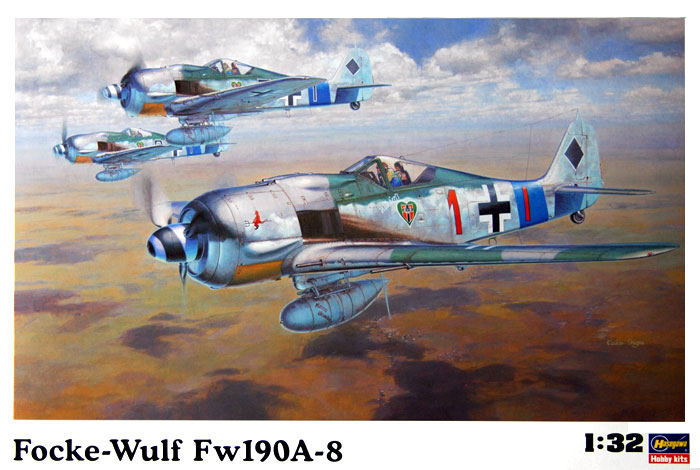
Hasegawa 1/32
S
u m m a r y
|
| Catalogue Number: |
Kit No. ST21 |
| Scale: |
1/32 |
| Contents and Media: |
112 parts in grey injection moulded
styrene (24 not used); 6 parts in clear; 4 polythene caps; markings for
two aircraft |
| Price: |
4,200 Yen |
| Review Type: |
FirstLook |
| Advantages: |
Accurate; simple & thoughtful parts
breakdown; crisply recessed panel lines; options include drop tank and
alternate 20mm cannon outer wing lower panels; very thin and clear canopy parts; engineered for
more variants in the future; .gorgeous Shigeo box art |
| Disadvantages: |
"Down" position of flaps too
extreme without modification; some detail is simplified (eg tail wheel assembly,
dimpled wheel well "roof", cockpit etc);
decals quite thick. |
| Recommendation: |
Highly Recommended |
Reviewed by Brett Green

Hasegawa's 1/32 scale Fw 190A-8 will be available for pre-order from Squadron.com
Almost exactly a year since the release of their
new-tool large scale Dora, Hasegawa has launched a 1/32 scale Focke-Wulf
Fw 190A-8.
The package arrived from Japan yesterday, only days
after release in Hasegawa's homeland market. Like a kid on Christmas
morning, I ripped open the shipping carton to be smacked in the eye with
one of the nicest examples of box art that I have seen for a long
time. The painting was done by the Japanese master artist,
Koike Shigeo.
The contents of the box were even more exciting than
the artwork.
112 grey plastic parts are supplied on 11 sprues.
Four of these sprues are common to last year's Fw 190D-9 kit, including
the wings and undercarriage gear. As a result, there are 24 parts not used
on this first Butcher Bird version.
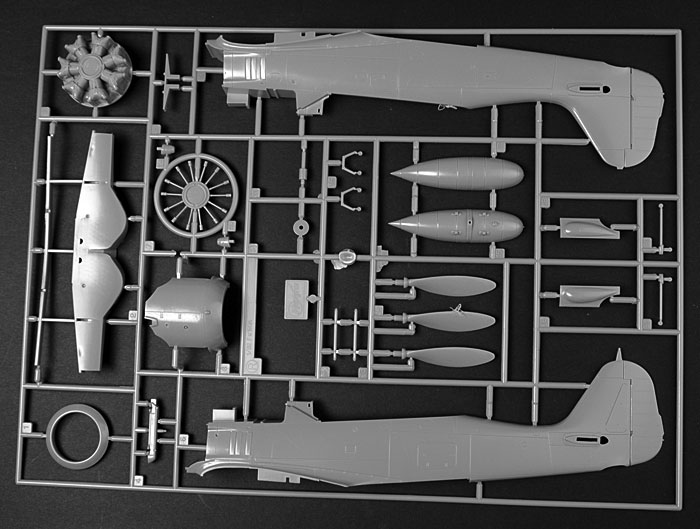
Click the
thumbnails below to view larger images:
All the parts are beautifully presented in shiny
plastic with crisply engraved panel lines. Texture on control surfaces
comprises fine raised lines. I like this low-key approach.
Probably in the interests of
simplicity, the cooling vents on the fuselage sides are moulded shut. Cockpit detail is
adequate, but some modeller will want to enhance this area.
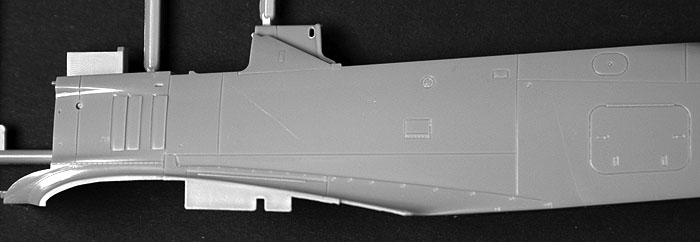
The engine is supplied as a single part moulded with
both rows of cylinders. This is not really a problem because not much can
be seen behind the cooling fan once the model is finished. Even so,
Hasegawa has moulded an ignition harness onto the front of the cylinders,
and also included a separate part with pushrods. Viewed from the front,
after careful painting, this assembly should look very effective.
Unlike the Dora, the Fw 190A had a fully enclosed
wheel well. The kit wheel well part is attached to the wing spar, ensuring
the correct dihedral. The characterisitc dimples in the top of the wheel
well are a little too cylindrical - they should look more like the dimples
on a golf ball. There are also a few ejector pin marks to deal with on the
gear bay and covers.
The late-style smooth drop tank from the Dora remains
in this box, in addition to a new standard 300 litre tank. The shape looks
a little odd to me.
Options are few. The landing flaps are separate parts
and may be depicted dropped, but the locating tabs should be repositioned
as the flaps are dropped too far without modification. Two styles of lower
access panel and ejector chute for the outer wing 20mm cannon position are
offered.
Only the early, flat canopy is included in this kit
but it is beautifully thin and free of optical distortion.
We will likely see the late bulged version in subsequent releases.
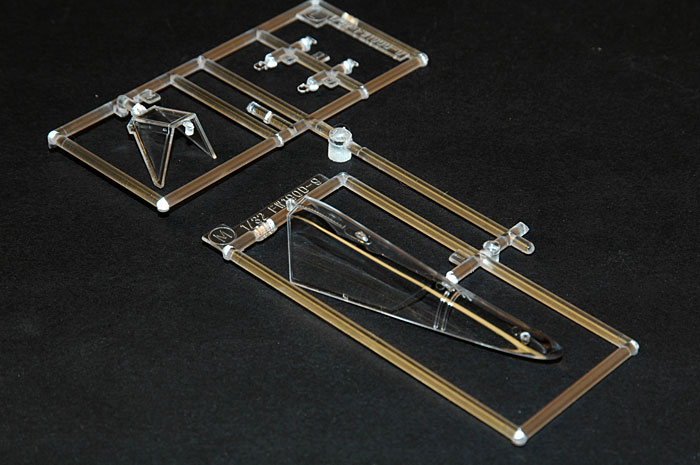
Construction should not present any problems,
although I admit that I shuddered when I saw the parts breakdown for the
five-piece engine cowl. It brought back some unpleasant memories of the
same configuration on 1/48 scale Dragon kits! Fortunately, it looks like
Hasegawa's engine and the solid fuselage assembly will provide enough
support to avoid most of the alignment problems experienced on
the smaller, older kit. Apart from this, construction should be even
simpler than the Dora kit, as there is no open wheel well and engine
detail to worry about.
The shape of the overall airframe looks very good. I am certain that
we will see a very detailed analysis of the profiles and contours of
important details including the spinner, prop blades and more over the
coming months.
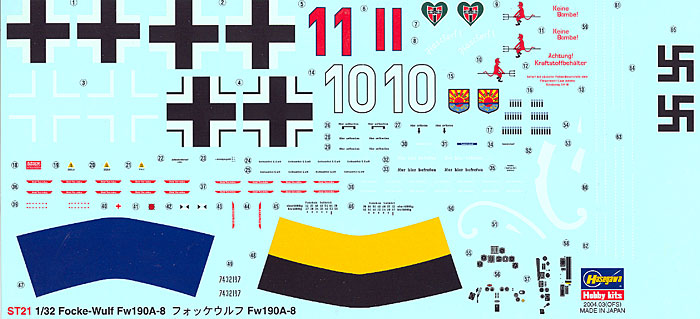
Markings are supplied for two aircraft - Hans Dortenmann's
Fw 190A-8 "Red 1" from 2./JG54 in June 1944; and "White 10" from 9./JG5 in
Norway during February, 1945. In common with the vast majority of Fw
190A-8s, these aircraft are both finished in 74/75/76 greys, but the RV
bands and other markings make them both attractive subjects.
Hasegawa has adopted a consistent strategy of
designing their new 1/32 scale kits to be accurate in outline, simple to
build, reasonably detailed and affordable. Indeed, their recent Fw 190D-9 and Bf
109 kits have not been fitted with astonishing detail, multimedia parts,
movable control surfaces, retracting undercarriage, flashing lights or
engine sounds.
They have, instead, focused on the basics; and
modellers have built these kits in extraordinary numbers.
Hasegawa's new 1/32 scale Focke-Wulf Fw 190A-8 continues
this approach.
After-market companies have embraced 1/32 scale with a flood of updates,
conversions, alternate markings and improved parts for modellers who want
a more detailed result. I am sure that we
won't be waiting long to see the first of these for Hasegawa's big Fw
190A-8.
Also, the parts breakdown and some scribing on the
engine cowl suggests that we will see both earlier and later versions of
the hard-working and versatile Butcher Bird from Hasegawa in the future.
Congratulations Hasegawa. In my opinion (for all
that is worth), you have found the magic formula for bringing joy to
the heart of the New Age Luftwaffe Modeller!
Highly Recommended
Review and Images Copyright © 2004 by
Brett Green
Page Created 02 April, 2003
Last updated 02 April, 2004
Back to HyperScale Main Page
Back to Reviews Page
|
Home | What's
New | Features
| Gallery |
Reviews | Reference
| Forum
| Search